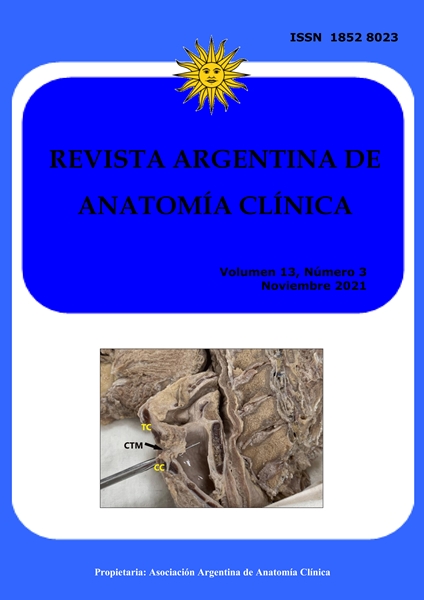EMERGENCY CRICOTHYROIDOTOMY PROCEDURE: LECTURE ON SURGICAL ANATOMY AND BRIEFING OF THE PROCEDURE FOLLOWED BY SKILL ASSESSMENT IN FIRST SEMESTER MEDICAL STUDENTS
DOI:
https://doi.org/10.31051/1852.8023.v13.n3.35049Keywords:
Medical students, Emergency Cricothyroidotomy, cadavers, hands on skillAbstract
Introduction: Emergency Cricothyroidotomy (ECT) is a life-saving procedure where the cricothyroid membrane is incised to access the larynx to establish breathing in ‘can’t intubate, can’t ventilate’ situations. This procedure can be taught along with midline neck anatomy to the first semester medical students and their understanding and application of knowledge could be assessed on cadavers. Materials and methods: Total three sessions was organized to expose and assess the first semester medical students about the Emergency Cricothyroidotomy (ECT) procedure. In each session, a two hour long integrated lecture was delivered regarding the surgical anatomy and the procedure. After that, randomly selected students were assigned a cadaver to locate and puncture the cricothyroid membrane with a sharp pointed wide probe. The time was recorded and pre and post session questionnaire was distributed and response was analysed. Result: The total study participants were 154. Analysis revealed knowledge and confidence of performing the procedure was statistically significantly increased (p <0.005) among the participants after the session. 90% participants successfully pierced the cricothyroid membrane as a team and the average time was 2 minutes 35 seconds. The most students gave a ‘good’ or ‘very good’ rating of this session. Conclusion: The medical students should be exposed to emergency life-saving procedures in relation to their anatomy course in earlier days of medical school. This could make them aware and oriented about the procedures which could be beneficial during their clinical training.
References
Boon JM, Abrahams PH, Meiring JH, Welch T. 2004. Cricothyroidotomy: a clinical anatomy review, Clin. Anat. 17: 478–486, https://doi.org/10.1002/ca. 10231
Battefort F, Bounes V, Pulcini M, Houze-Cerfon CH, Ducassé JL. 2007. Prehospital cricothyrotomy: a case report. Ann Fr Anesth Reanim. 26(2):171-3. French. doi: 10.1016/j.annfar.2006.11.009. PMID: 17174062.
Carvey MM, Baek WK, Gluschitz S, Hage R. 2020. The necessity of practical emergency cricothyroidotomy training during undergraduate medical education. Translational Research in Anatomy 19:1-6. https://doi.org/10.1016/j.tria.2020.100070
Davis KA, Edgar-Zarate CL, Bonilla-Velez J, Atkinson TN, Tulunay-Ugur OE, Agarwal A. 2019. Using Didactics and Simulation to Enhance Comfort, Knowledge, and Skills of Nonsurgical Trainees Caring for Patients with Tracheostomy and Laryngectomy. Simul Healthc. 14(6):384-390. doi: 10.1097/SIH.0000000000000392
DiGiacomo C, Neshat KK, Angus LD, Penna K, Sadoff RS, Shaftan GW. 2003. Emergency cricothyrotomy. Mil Med. 168(7):541-4. PMID: 12901463.
Hall AB. 2011. Randomized objective comparison of live tissue training versus simulators for emergency procedures. Am Surg. 77(5):561-5. doi: 10.1177/000313481107700514. PMID: 21679588.
Helm M, Hossfeld B, Jost C, Lampl L, Böckers T. 2012. Emergency cricothyroidotomy performed by inexperienced clinicians—surgical technique versus indicator-guided puncture technique, Emerg. Med. J. 30 (8): 646–649, https://doi.org/10.
Hill C, Reardon R, Joing S, Falvey D, Miner J. 2010. Cricothyrotomy Technique Using Gum Elastic Bougie Is Faster Than Standard Technique: A Study of Emergency Medicine Residents and Medical Students in an Animal Lab ACAD EMERG MED. 17(6): 666-669. www.aemj.org doi: 10.1111/j.1553-2712.2010.00753.x
Hwang K, Kim HJ, Kim YC, Choi YS, Hwang SW. 2014. Manikin model with breathing tube for wire-guided percutaneous cricothyrotomy in patients applying an intermaxillary fixation. J Craniofac Surg. 25(5):1846-8. doi:10.1097/SCS.0000000000000576. PMID: 25203581.
Kattan E, De la Fuente R, Putz F, Vera M, Corvetto M, Inzunza O, Achurra P, Inzunza M, Munoz-Gama J, Sepulveda M, Galvez V, Pavez N, Retamal J, Bravo S. 2021. Simulation-Based Mastery Learning of Bronchoscopy-Guided Percutaneous Dilatational Tracheostomy: Competency Acquisition and Skills Transfer to a Cadaveric Model. Simul Healthc. 16(3):157-162. doi: 10.1097/SIH.0000000000000491. PMID: 32701863.
Mayer AW, Smith KA, Carrie S. 2020. A survey of ENT undergraduate teaching in the UK. J Laryngol Otol. 134(6):553-557. doi: 10.1017/S0022215120000936.
Melker JS, Gabrielli A. 2005. Melker cricothyrotomy kit: an alternative to the surgical technique. Ann Otol Rhinol Laryngol. 114:525–8.
Quintana Díaz M, Sánchez Casado M, López de Toro I, Hermoso Alarza F, García de Lorenzo A. 2009. Encuesta del conocimiento de la especialidad de Medicina Intensivay el funcionamiento de una unidad de cuidados intensivos por los estudiantes de medicina [A national survey of medical students about the specialty of Intensive Medicine and intensive care units]. Med Intensiva. 33(8):363-9. Spanish. doi: 10.1016/j.medin.2009.05.010. PMID: 19912967
Schober P, Hegemann MC, Schwarte LA, Loer SA, Noetges P. 2009. Emergency cricothyrotomy-a comparative study of different techniques in human cadavers. Resuscitation. 80(2):204-9. doi: 10.1016/j.resuscitation.2008.10.023.
Tokarz E, Szymanowski AR, Loree JT, Muscarella J. 2021. Gaps in Training: Misunderstandings of Airway Management in Medical Students and Internal Medicine Residents. Otolaryngol Head Neck Surg. 164(5):938-943. doi: 10.1177/0194599820949528.
Yelverton JC, Nguyen JH, Wan W, Kenerson MC, Schuman TA. Effectiveness of a standardized education process for tracheostomy care. Laryngoscope. 125 (2):342-7. doi: 10.1002/lary.24821. PMID: 25041983
Downloads
Published
Issue
Section
License
Copyright (c) 2021 Anasuya Ghosh, Subhramoy Chaudhury

This work is licensed under a Creative Commons Attribution-NonCommercial 4.0 International License.
Authors retain copyright and grant the journal right of first publication with the work simultaneously licensed under a Creative Commons Attribution License that allows others to share the work with an acknowledgement of the work's authorship and initial publication in this journal. Use restricted to non commercial purposes.
Once the manuscript has been accepted for publications, authors will sign a Copyright Transfer Agreement to let the “Asociación Argentina de Anatomía Clínica” (Argentine Association of Clinical Anatomy) to edit, publish and disseminate the contribution.



